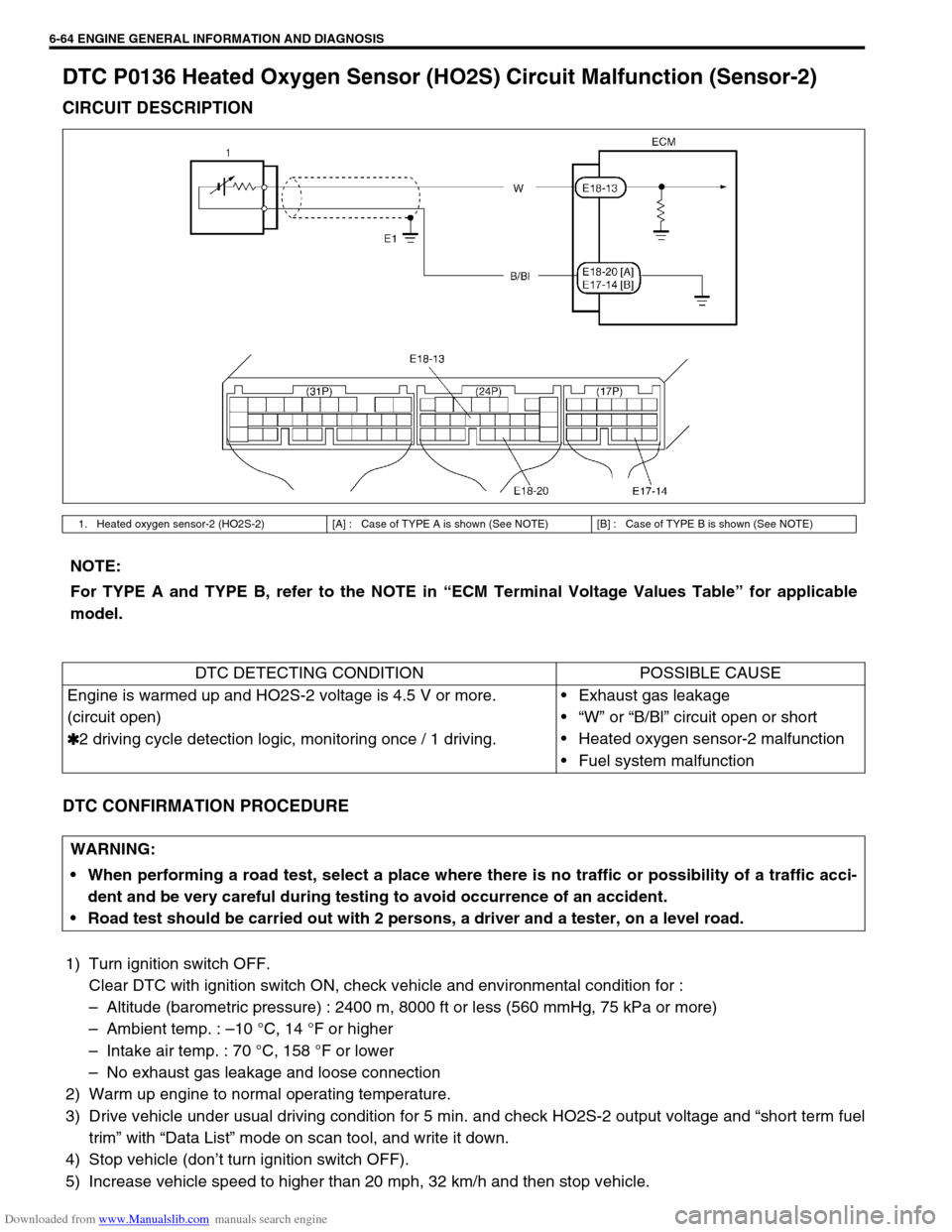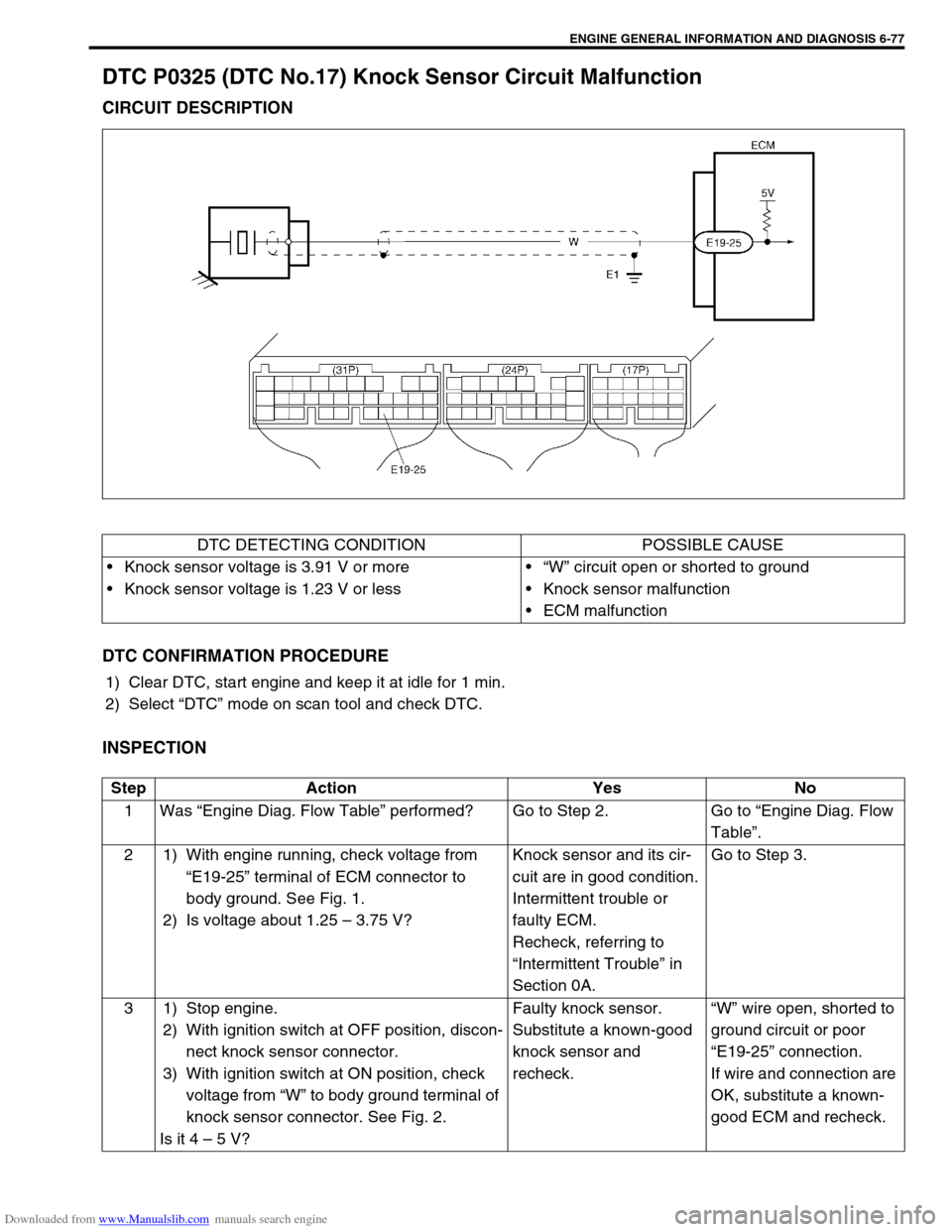Page 418 of 687
Downloaded from www.Manualslib.com manuals search engine ENGINE GENERAL INFORMATION AND DIAGNOSIS 6-61
DTC P0133 Heated Oxygen Sensor (HO2S) Circuit Slow Response (Sensor-1)
WIRING DIAGRAM
Refer to DTC P0130 section.
CIRCUIT DESCRIPTION
Fig. 1
DTC CONFIRMATION PROCEDURE
Refer to DTC P0130 section.
INSPECTION
DTC DETECTING CONDITION POSSIBLE CAUSE
When running at specified idle speed after engine warmed up and
running at specified vehicle speed, response time (time to change
from lean to rich or from rich to lean) of HO2S-1 output voltage is
about 1 sec. at minimum or average time of 1 cycle is 5 sec. at
minimum. See. Fig. 1
✱
✱✱ ✱2 driving cycle detection logic, Monitoring once / 1 driving.Heated oxygen sensor-1 malfunction
Step Action Yes No
1Was “Engine Diag. Flow Table” performed? Go to Step 2. Go to “Engine Diag. Flow
Table”.
2 Is there DTC(s) other than HO2S-1 (DTC
P0133)?Go to applicable DTC
Diag. Flow Table.Replace HO2S-1.
Page 419 of 687

Downloaded from www.Manualslib.com manuals search engine 6-62 ENGINE GENERAL INFORMATION AND DIAGNOSIS
DTC P0135 (DTC No.14) Heated Oxygen Sensor (HO2S) Heater Circuit Mal-
function (Sensor-1)
CIRCUIT DESCRIPTION
DTC CONFIRMATION PROCEDURE
1) Turn ignition switch OFF.
2) Clear DTC with ignition switch ON, start engine and keep it at idle for 1 min.
3) Start vehicle and depress accelerator pedal fully for 5 sec. or longer.
4) Stop vehicle.
5) Check DTC in “DTC” mode and pending DTC in “ON BOARD TEST” or “PENDING DTC” mode.
1. Heated oxygen sensor-1 (HO2S-1) heater
DTC DETECTING CONDITION POSSIBLE CAUSE
DTC will set when A or B condition is met.
A :
Low voltage at terminal E19-7 when engine is running
at high load.
B :
High voltage at terminal E19-7 when engine is running
under condition other than above.
✱
✱✱ ✱2 driving cycle detection logic, Continuous monitoring.HO2S-1 heater circuit open or shorted to ground
ECM malfunction
WARNING:
When performing a road test, select a place where there is no traffic or possibility of a traffic acci-
dent and be very careful during testing to avoid occurrence of an accident.
Road test should be carried out with 2 persons, a driver and a tester.
Page 421 of 687

Downloaded from www.Manualslib.com manuals search engine 6-64 ENGINE GENERAL INFORMATION AND DIAGNOSIS
DTC P0136 Heated Oxygen Sensor (HO2S) Circuit Malfunction (Sensor-2)
CIRCUIT DESCRIPTION
DTC CONFIRMATION PROCEDURE
1) Turn ignition switch OFF.
Clear DTC with ignition switch ON, check vehicle and environmental condition for :
–Altitude (barometric pressure) : 2400 m, 8000 ft or less (560 mmHg, 75 kPa or more)
–Ambient temp. : –10 °C, 14 °F or higher
–Intake air temp. : 70 °C, 158 °F or lower
–No exhaust gas leakage and loose connection
2) Warm up engine to normal operating temperature.
3) Drive vehicle under usual driving condition for 5 min. and check HO2S-2 output voltage and “short term fuel
trim” with “Data List” mode on scan tool, and write it down.
4) Stop vehicle (don’t turn ignition switch OFF).
5) Increase vehicle speed to higher than 20 mph, 32 km/h and then stop vehicle.
1. Heated oxygen sensor-2 (HO2S-2) [A] : Case of TYPE A is shown (See NOTE) [B] : Case of TYPE B is shown (See NOTE)
NOTE:
For TYPE A and TYPE B, refer to the NOTE in “ECM Terminal Voltage Values Table” for applicable
model.
DTC DETECTING CONDITION POSSIBLE CAUSE
Engine is warmed up and HO2S-2 voltage is 4.5 V or more.
(circuit open)
✱
✱✱ ✱2 driving cycle detection logic, monitoring once / 1 driving.Exhaust gas leakage
“W” or “B/Bl” circuit open or short
Heated oxygen sensor-2 malfunction
Fuel system malfunction
WARNING:
When performing a road test, select a place where there is no traffic or possibility of a traffic acci-
dent and be very careful during testing to avoid occurrence of an accident.
Road test should be carried out with 2 persons, a driver and a tester, on a level road.
Page 423 of 687
Downloaded from www.Manualslib.com manuals search engine 6-66 ENGINE GENERAL INFORMATION AND DIAGNOSIS
DTC P0141 Heated Oxygen Sensor (HO2S) Heater Circuit Malfunction (Sen-
sor-2)
CIRCUIT DESCRIPTION
DTC CONFIRMATION PROCEDURE
1) Turn ignition switch OFF once and then ON.
2) Clear DTC, start engine and warm up engine to normal operating temperature.
3) Keep it at 2000 r/min for 2 min.
4) Check pending DTC in “ON BOARD TEST” or “PENDING DTC” mode and DTC in “DTC” mode.
DTC DETECTING CONDITION POSSIBLE CAUSE
DTC will set when A or B condition it met.
1) Low voltage at terminal E18-4 for specified time after
engine start or while engine running at high load.
2) High voltage at terminal E18-4 while engine running
under other than above condition.
✱
✱✱ ✱2 driving cycle detection logic, continuous monitoring.HO2S-2 heater circuit open or shorted to ground
ECM malfunction
Page 425 of 687
![SUZUKI JIMNY 2005 3.G Service Workshop Manual Downloaded from www.Manualslib.com manuals search engine 6-68 ENGINE GENERAL INFORMATION AND DIAGNOSIS
DTC P0171 Fuel System Too Lean
DTC P0172 Fuel System Too Rich
CIRCUIT DESCRIPTION
[a] : Signal to SUZUKI JIMNY 2005 3.G Service Workshop Manual Downloaded from www.Manualslib.com manuals search engine 6-68 ENGINE GENERAL INFORMATION AND DIAGNOSIS
DTC P0171 Fuel System Too Lean
DTC P0172 Fuel System Too Rich
CIRCUIT DESCRIPTION
[a] : Signal to](/manual-img/20/7588/w960_7588-424.png)
Downloaded from www.Manualslib.com manuals search engine 6-68 ENGINE GENERAL INFORMATION AND DIAGNOSIS
DTC P0171 Fuel System Too Lean
DTC P0172 Fuel System Too Rich
CIRCUIT DESCRIPTION
[a] : Signal to decrease amount of fuel injection [d] : A/F mixture becomes richer
(Oxygen concentration decreases)1. Injector
[b] : Signal to increase amount of fuel injection [e] : High voltage 2. Heated oxygen sensor-1 (HO2S-1)
[c] : A/F mixture becomes leaner
(Oxygen concentration increases)[f] : Low voltage
DTC DETECTING CONDITION POSSIBLE CAUSE
When following condition occurs while engine running
under closed loop condition.
–Air / fuel ratio too lean
(Total fuel trim (short and long terms added) is more
than 30%)
or
–Air / fuel ratio too rich
(Total fuel trim is less than –30%)
✱
✱✱ ✱2 driving cycle detection logic, continuous monitoring.Vacuum leaks (air drawn in).
Exhaust gas leakage.
Heated oxygen sensor-1 circuit malfunction.
Fuel pressure out of specification.
Fuel injector malfunction (clogged or leakage).
MAP sensor poor performance.
ECT sensor poor performance.
IAT sensor poor performance.
TP sensor poor performance.
EVAP control system malfunction.
PCV valve malfunction.
Page 429 of 687

Downloaded from www.Manualslib.com manuals search engine 6-72 ENGINE GENERAL INFORMATION AND DIAGNOSIS
DTC P0300 Random Misfire Detected (Misfire Detected at 2 or More Cylinders)
DTC P0301 Cylinder 1 Misfire Detected
DTC P0302 Cylinder 2 Misfire Detected
DTC P0303 Cylinder 3 Misfire Detected
DTC P0304 Cylinder 4 Misfire Detected
CIRCUIT DESCRIPTION
ECM monitors crankshaft revolution speed and engine speed via the crankshaft position sensor and cylinder No.
via the camshaft position sensor. Then it calculates the change in the crankshaft revolution speed and from how
many times such change occurred in every 200 or 1000 engine revolutions, it detects occurrence of misfire.
When ECM detects a misfire (misfire rate per 200 revolutions) which can cause overheat and damage to the
three way catalytic converter, it makes the malfunction indicator lamp (MIL) flash as long as misfire occurs at
that rate.
After that, however, when the misfire rate drops, MIL remains ON until it has been judged as normal 3 times
under the same driving conditions.
Also, when ECM detects a misfire (misfire rate per 1000 revolutions) which will not cause damage to three way
catalytic converter but can cause exhaust emission to be deteriorated, it makes MIL light according to the 2 driv-
ing cycle detection logic.
1. Ignition coil assembly (for No.1 and No.4 cylinder)
2. Ignition coil assembly (for No.2 and No.3 cylinder)
3. Fuel injector
4. CKP sensor
5. CMP sensor
Page 434 of 687

Downloaded from www.Manualslib.com manuals search engine ENGINE GENERAL INFORMATION AND DIAGNOSIS 6-77
DTC P0325 (DTC No.17) Knock Sensor Circuit Malfunction
CIRCUIT DESCRIPTION
DTC CONFIRMATION PROCEDURE
1) Clear DTC, start engine and keep it at idle for 1 min.
2) Select “DTC” mode on scan tool and check DTC.
INSPECTION
DTC DETECTING CONDITION POSSIBLE CAUSE
Knock sensor voltage is 3.91 V or more
Knock sensor voltage is 1.23 V or less“W” circuit open or shorted to ground
Knock sensor malfunction
ECM malfunction
Step Action Yes No
1Was “Engine Diag. Flow Table” performed? Go to Step 2. Go to “Engine Diag. Flow
Table”.
2 1) With engine running, check voltage from
“E19-25” terminal of ECM connector to
body ground. See Fig. 1.
2) Is voltage about 1.25 – 3.75 V?Knock sensor and its cir-
cuit are in good condition.
Intermittent trouble or
faulty ECM.
Recheck, referring to
“Intermittent Trouble” in
Section 0A.Go to Step 3.
3 1) Stop engine.
2) With ignition switch at OFF position, discon-
nect knock sensor connector.
3) With ignition switch at ON position, check
voltage from “W” to body ground terminal of
knock sensor connector. See Fig. 2.
Is it 4 – 5 V?Faulty knock sensor.
Substitute a known-good
knock sensor and
recheck.“W” wire open, shorted to
ground circuit or poor
“E19-25” connection.
If wire and connection are
OK, substitute a known-
good ECM and recheck.
Page 436 of 687
Downloaded from www.Manualslib.com manuals search engine ENGINE GENERAL INFORMATION AND DIAGNOSIS 6-79
DTC P0335 (DTC No.23) Crankshaft Position (CKP) Sensor Circuit Malfunction
CIRCUIT DESCRIPTION
REFERENCE
Connect oscilloscope between terminals E19-23 of ECM connector connected to ECM and body ground and
check CKP sensor signal.
DTC CONFIRMATION PROCEDURE
1) Clear DTC and crank engine for 2 sec.
2) Select “DTC” mode on scan tool and check DTC.
DTC DETECTING CONDITION POSSIBLE CAUSE
NO CKP sensor signal for 2 seconds at engine crank-
ing.CKP sensor circuit open or short.
Signal teeth damaged.
CKP sensor malfunction, foreign material being
attached or improper installation.
ECM malfunction.
1. 10° signal [A] : Oscilloscope Waveforms [C] : Waveforms at 2000 rpm
2. 30° signal [B] : Waveforms at idle speed